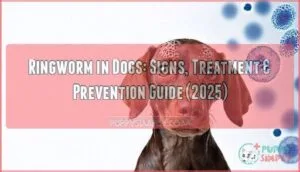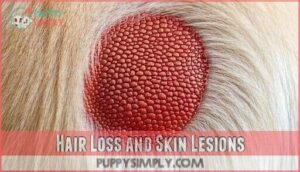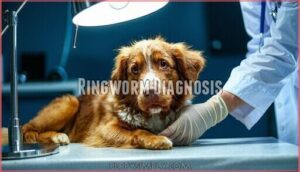This site is supported by our readers. We may earn a commission, at no cost to you, if you purchase through links.

These microscopic fungi called dermatophytes feed on keratin in hair, skin, and nails, causing scaly, red lesions that can spread rapidly.
The condition is highly contagious to other pets and humans through direct contact or contaminated surfaces.
You’ll typically notice round bald spots, broken hair, and sometimes mild itching.
While it sounds scary, ringworm responds well to antifungal treatments combined with thorough environmental cleaning.
Most dogs recover completely within 6-12 weeks with proper veterinary care, though isolation during treatment prevents spreading to family members and other pets.
Table Of Contents
- Key Takeaways
- What is Ringworm
- Ringworm Symptoms
- Ringworm Diagnosis
- Ringworm Transmission
- Ringworm in Other Animals
- Human Ringworm Risk
- Ringworm Treatment
- Ringworm Recovery
- Ringworm Prevention
- Frequently Asked Questions (FAQs)
- How contagious is ringworm from a dog to a human?
- Will ringworm in a dog go away on its own?
- How can I tell if my dog has ringworm?
- Are there home remedies to help dogs with ringworm?
- How do you treat ringworm in dogs?
- Can humans catch ringworm from dogs?
- What happens if ringworm is untreated in dogs?
- Is there a vaccine available to prevent ringworm infections in dogs?
- How long does ringworm treatment typically take?
- Can dogs get ringworm multiple times?
- Conclusion
Key Takeaways
- You’re dealing with a fungal infection, not worms – Despite its name, ringworm is caused by dermatophytes that feed on your dog’s skin and hair, creating those telltale circular bald patches with scaly, red edges.
- It’s highly contagious to everyone in your household – Your dog can spread ringworm to other pets and humans through direct contact or contaminated surfaces, with fungal spores surviving up to 18 months in your environment.
- You’ll need both medication and deep cleaning to win – Effective treatment requires your vet’s prescribed antifungal medications (topical and oral) combined with thorough environmental disinfection using bleach solutions or steam cleaning.
- Complete recovery takes 6-12 weeks with proper care – Most dogs make a full recovery when you follow the treatment plan consistently, though you’ll need to continue medication until follow-up testing confirms the infection is completely gone.
What is Ringworm
Despite its name, ringworm isn’t caused by worms at all—it’s actually a fungal infection that affects your dog’s skin, hair, and sometimes nails.
This sneaky infection gets its misleading name from the circular, ring-shaped lesions it often creates on your pet’s skin, which can be a key indicator of the infection.
Fungal Infection Causes
Despite its misleading name, ringworm isn’t caused by worms at all. Your dog’s skin infection stems from dermatophytes, specialized fungi that feast on dead skin cells and hair.
These microscopic troublemakers create the classic circular lesions that give ringworm its name. Fungal spores spread easily through direct contact or contaminated surfaces, making canine ringworm highly contagious.
These sneaky fungal spores hitchhike on everything, turning your home into a contamination zone for months.
The dermatophyte infection targets your dog’s outer skin layers, causing characteristic hair loss and scaly patches. Understanding these fungal transmission patterns helps you recognize why your furry friend developed this stubborn dog skin infection.
Maintaining good dog health practices is essential in preventing the spread of ringworm and other infections, which is crucial for your dog’s overall health and wellbeing to prevent infections.
Common Causative Fungi
Three main fungal species cause canine ringworm infections, each with distinct characteristics.
These dermatophytes have specialized abilities to break down keratin in your dog’s skin, hair, and nails.
Understanding which fungi types affect dogs helps you recognize infection patterns and treatment approaches.
The primary fungal species responsible for canine ringworm include:
- Microsporum canis – Causes 70% of dog ringworm cases and spreads easily between pets and humans
- Microsporum gypseum – Accounts for 20% of infections, typically contracted from contaminated soil during digging
- Trichophyton mentagrophytes – Responsible for 10% of cases, often causing more severe skin inflammation
- Mixed infections – Occasionally, dogs contract multiple dermatophytes simultaneously, complicating diagnosis and treatment
Ringworm Symptoms
You’ll notice ringworm symptoms develop gradually, starting with small patches of hair loss that can appear anywhere on your dog’s body.
These telltale signs include circular bald spots with red, scaly edges and brittle hair that breaks off easily near the skin.
Hair Loss and Skin Lesions
Circular patches tell the story of ringworm’s destructive path through your dog’s coat.
You’ll notice distinct hair loss patterns where infected follicles weaken and break.
These skin lesions often feature red, scaly borders with potential healing centers, creating the classic ring appearance that gives dermatophytosis its name.
| Ringworm Symptom | What You’ll See |
|---|---|
| Hair Loss Pattern | Circular or irregular patches of missing fur |
| Lesion Appearance | Red, crusty edges with possible clear centers |
| Hair Condition | Dry, brittle strands that break easily |
| Skin Texture | Scaly, inflamed areas around affected zones |
| Scalp Irritation | Rough, damaged skin requiring lesion treatment |
The follicle damage creates weak points where hair snaps off rather than falling out naturally, leaving stubble-like remnants that signal active skin infections requiring prompt veterinary attention.
Itchiness and Nail Problems
Your dog might start scratching more than usual as ringworm in dogs progresses beyond visible skin lesions.
You’ll notice increased itchiness that leads to excessive licking, particularly around affected areas.
Watch for these nail-related symptoms:
- Nail deformities – claws become misshapen or grow abnormally
- Claw brittleness – nails break easily or appear dry and cracked
- Paw sensitivity – your pet may favor certain paws or resist handling
Secondary infections can develop when constant scratching creates open wounds.
Nail infections often accompany ringworm symptoms dogs display, making early detection important for preventing complications.
Ringworm Diagnosis
When you suspect your dog has ringworm, getting an accurate diagnosis requires proper veterinary testing rather than guessing based on symptoms alone.
Your vet will use several diagnostic methods including physical examination, fungal culture testing, and sometimes a Wood’s lamp to confirm the infection and identify the specific fungal species involved.
Physical Exam and Fungal Culture
When examining suspected ringworm in dogs, your veterinarian conducts a thorough physical exam, carefully noting lesion appearance and affected areas.
Sample collection involves gathering hair, scales, or scabs from infected sites for microscopic analysis.
Fungal culture remains the gold standard for ringworm diagnosis dogs, using specialized culture mediums to grow collected specimens over 3-21 days.
This method provides definitive identification of the causative fungal infection dogs, and while PCR accuracy offers faster results within 3-5 days by detecting fungal DNA, though culture remains more thorough for complete diagnosis confirmation, making it a crucial step for complete diagnosis.
Wood’s Lamp Examination
Utilizing a Woods lamp for ringworm diagnosis dogs provides quick UV fluorescence screening in veterinary practice.
This examination accuracy depends on the fungal species detection, as only 50-60% of Microsporum canis strains glow bright apple-green under ultraviolet light.
The procedure details require positioning the lamp 5-10 cm from lesions in complete darkness for 3-5 minutes.
However, false positives occur when medications or debris fluoresce similarly.
Since many fungal infection dogs don’t show fluorescence, negative results don’t rule out ringworm contagious dogs, making additional testing essential for accurate ringworm vet treatment decisions.
The use of a Woods lamp is just one tool, and its limitations, including the potential for false positives, must be considered in the diagnostic process.
Ringworm Transmission
Ringworm spreads incredibly easily from dog to dog, dog to human, and even through contaminated objects in your home.
The fungal spores can survive on surfaces for up to 18 months, making thorough environmental cleaning just as important as treating your infected pet, which involves complete concepts of cleaning and treatment.
Direct Contact and Contagion
Ringworm spreads like wildfire through direct contact with infected animals, contaminated objects, or even humans carrying the fungus.
Your dog can catch this contagious disease simply by touching an infected pet, sharing toys, or walking on surfaces where spores have settled.
The fungus doesn’t discriminate—it jumps from dogs to cats to humans with ease, and children, elderly individuals, and immunocompromised people face the highest risk of human transmission.
Brushes, bedding, and grooming tools become vehicles for object contamination, making ringworm transmission a household concern that requires vigilant prevention measures.
Fungal Spores and Environmental Risk
Spore viability extends far beyond your dog’s immediate contact zone.
These microscopic troublemakers can survive on surfaces for up to 18 months, creating persistent contamination sources throughout your home.
Pet environment factors like humidity and warmth boost environmental persistence, making carpets, bedding, and grooming tools fungal hotspots.
Regular household cleaning won’t cut it—you need proper disinfection protocols using bleach solutions or steam cleaning.
Without thorough environmental disinfection, you’re fighting an uphill battle against pet fungal infections that keep circulating through contaminated surfaces.
Ringworm in Other Animals
Your dog isn’t the only animal that can catch ringworm from contaminated surfaces or direct contact with infected pets.
Cats are particularly susceptible to ringworm, with nearly all feline cases caused by the same fungus that affects dogs, and livestock like horses, cattle, and goats can also develop infections that spread to humans.
Cats and Feline Ringworm
Cats face higher feline susceptibility to ringworm than dogs, with 98% of infections caused by Microsporum canis.
Multi-cat households create perfect conditions for rapid spread since asymptomatic carriers can unknowingly transmit the fungus. Long-haired breeds and kitten infections pose additional challenges because dense coats hide symptoms while young immune systems struggle against the pathogen.
You’ll need ringworm treatment dogs and cats receive simultaneously, as zoonotic ringworm easily jumps between species. When ringworm contagious dogs interact with felines, cross-contamination becomes inevitable.
Livestock and Zoonotic Risk
Most animals on your farm can catch and spread zoonotic ringworm, creating significant human susceptibility risks.
Livestock transmission occurs through direct contact, shared equipment, and contaminated facilities.
Rural exposure increases when proper farm biosecurity measures aren’t followed.
- Cattle, horses, sheep, and goats commonly carry ringworm spores
- Shared grooming tools spread infection between animals rapidly
- Children and elderly family members face higher infection risks
- Proper hygiene prevents dangerous human-animal transmission cycles
Zoonotic diseases like ringworm contagious dogs spread require immediate attention and consistent zoonotic prevention protocols to protect your family’s health.
Regular deworming can help prevent other parasitic infections that cause common symptoms in dogs.
Human Ringworm Risk
Your dog’s ringworm doesn’t just affect them—it can spread to you and your family members through direct contact or contaminated surfaces.
Children, elderly individuals, and people with weakened immune systems face the highest risk of infection from infected pets, particularly through direct contact.
Zoonotic Transmission and Prevention
Understanding the bridge between pets and people reveals critical insights about ringworm transmission.
Dogs with ringworm shed fungal spores through direct contact and contaminated surfaces, creating Human Risk Factors that affect family health.
These Transmission Routes include petting, grooming, and shared bedding where spores survive 18 months.
| Prevention Method | Effectiveness | Implementation |
|---|---|---|
| Hand washing after pet contact | 60% risk reduction | Soap and water, 20 seconds |
| Environmental disinfection | 99% spore elimination | Bleach solutions on surfaces |
| Pet isolation during treatment | 80% fewer secondary cases | Separate room with hard floors |
Proper Hygiene Practices substantially reduce zoonotic diseases transmission.
Child Safety requires supervised interactions, while Immunocompromised Protection demands stricter precautions during ringworm prevention efforts to safeguard human-animal transmission.
Vulnerable Individuals and Precautions
Some family members face higher ringworm risks than others. Children are particularly vulnerable due to their developing immune systems and close contact with pets.
Elderly individuals and immunocompromised people need extra protection since their bodies struggle to fight infections. Keep these at-risk family members away from infected dogs during treatment.
Implement quarantine measures by confining your dog to easily cleanable areas. Senior dogs and puppies also require careful monitoring, as their immune systems may not handle infections as effectively as healthy adult dogs.
Protecting your dog with core and non-core vaccines can also help prevent other diseases.
Ringworm Treatment
When your dog has ringworm, you’ll need to tackle it with both direct treatment and thorough environmental cleaning to prevent reinfection.
Your vet will likely recommend a combination approach using topical treatments like medicated shampoos or creams alongside oral antifungal medications for more effective results, which will help achieve complete healing.
Topical Therapy and Oral Medications
Your vet will prescribe ringworm treatment dogs using combined therapy for maximum medication efficacy. This approach pairs topical therapy with oral medications to tackle fungal infections thoroughly.
Treatment typically involves three main components:
- Topical Application – Medicated shampoos, creams, or lime sulfur dips applied 2-3 times weekly to affected areas and surrounding coat
- Oral Antifungal Medications – Daily pills like itraconazole or terbinafine for 4-6 weeks, continuing until negative cultures confirm clearance
- Monitoring Protocol – Regular vet checkups to assess progress and watch for oral side-effects like liver enzyme elevation
Treatment duration varies but typically spans 6-12 weeks. You may also want to think about using ringworm shampoo for dogs as part of the topical application. Your vet may adjust the ringworm medication dogs receive based on infection severity and your dog’s response to therapy.
Environmental Decontamination
Cleaning contaminated surfaces breaks the cycle of reinfection and protects your entire household. Environmental decontamination requires thorough disinfection using bleach solution or steam cleaning to eliminate fungal spores that survive up to 18 months on surfaces.
An antifungal cleaning solution is essential for effective sanitation.
| Cleaning Task | Method & Frequency |
|---|---|
| Vacuuming Frequency | Daily removal of shed fur and skin cells |
| Bedding Sanitation | Wash pet bedding weekly in hot water with disinfectant |
| Kennel Cleaning | Steam clean or bleach solution (1:10 ratio) daily |
| Surface Disinfection | Wipe all surfaces with antifungal cleaner twice weekly |
| Disinfectant Efficacy | Use EPA-approved products for maximum spore viability elimination |
Focus on areas where your dog spends time, including furniture and carpets. Pet disinfection extends beyond treatment to thorough environmental management.
Ringworm Recovery
Recovery from ringworm takes patience, but you’ll know your dog is getting better when new hair starts growing in the affected areas and lesions begin healing from the center outward.
Most dogs make a complete recovery within 6-12 weeks of consistent treatment, though you’ll need to continue medication until your vet confirms the infection is completely gone through follow-up testing.
Contagious Period and Prevention
Your dog remains contagious throughout the infection duration until successful treatment completion.
Your infected dog spreads ringworm until treatment fully clears the stubborn fungal infection.
During quarantine protocols, implement strict spread mitigation measures by isolating infected pets from healthy animals and family members.
Spore viability extends up to 18 months on surfaces, creating significant reinfection risks without proper environmental decontamination.
Focus ringworm prevention dogs strategies on containing contagious diseases through dedicated spaces with hard floors for easier cleaning.
Monitor household members for symptoms while maintaining prevention protocols.
Environmental decontamination prevents ringworm spread to other pets and humans in your home, and is crucial for overall disease control.
Full Recovery and Prognosis
Most dogs achieve complete recovery within two to four months when treatment completion follows your veterinarian’s recommendations.
Negative fungal cultures confirm successful pet recovery, but treatment duration varies based on infection severity and your dog’s immune response.
Recurrence risks remain low with proper post-treatment care, though some dogs may experience treatment recurrence if environmental decontamination wasn’t thorough.
Long-term effects are rare in healthy dogs. Continue monitoring for symptoms even after recovery, as your pet’s strengthened immune system provides better protection against future infections.
Regular vet visits are essential for early detection of issues, ensuring your dog receives the necessary care to prevent complications and maintain overall health.
Ringworm Prevention
Prevention starts with understanding that ringworm spores can survive in your environment for up to 18 months, making thorough cleaning essential.
You’ll need to combine regular screening of new pets with consistent environmental disinfection to keep your dog and family safe from this highly contagious fungal infection, which is a highly infectious disease that requires immediate attention.
Environmental Cleaning and Disinfection
Preventing reinfection requires thorough environmental cleaning since fungal spores maintain viability for up to 18 months on surfaces.
Your disinfectant choices should include sodium hypochlorite solutions or quaternary ammonium compounds for maximum effectiveness against persistent spores.
To confirm you have reliable cleaning products, consider purchasing solutions specifically designed for pet environments.
Key environmental cleaning strategies include:
- Daily vacuuming frequency removes shed fur and reduces spore load by 60% within two weeks
- Hot water bedding sanitation at temperatures above 50°C kills 98% of contaminating spores
- Steam cleaning fabric surfaces achieves 95% spore eradication compared to dry cleaning methods
Comprehensive pet disinfection methods prevent cross-contamination between household animals and support your dog’s recovery process.
Regular Screening and Isolation
Early detection through regular screening helps identify asymptomatic carriers before they spread infection.
Screen new pets before introducing them to your household using ringworm diagnosis methods like fungal cultures. Implement quarantine protocols by isolating suspicious dogs for at least two weeks.
In kennel management, separate new arrivals from resident animals until cleared by veterinary examination. These preventative measures create effective pet isolation barriers, protecting healthy animals.
Quarantine remains your strongest defense against ringworm outbreaks, especially when combined with proper ringworm prevention dogs protocols and systematic monitoring of all animals.
Frequently Asked Questions (FAQs)
How contagious is ringworm from a dog to a human?
Ringworm spreads easily from dogs to humans through direct contact or contaminated objects. You’re especially vulnerable if you’re a child, elderly, or immunocompromised, making proper hygiene essential.
Will ringworm in a dog go away on its own?
Unfortunately, ringworm won’t disappear without treatment.
Picture those stubborn fungal spores clinging to your dog’s skin and hair—they’re built to survive and spread.
You’ll need antifungal medications to eliminate the infection completely, and it’s crucial to understand that these medications are essential for removing the fungal infection.
How can I tell if my dog has ringworm?
Look for circular patches of hair loss with red, crusty edges, broken or brittle hair that breaks easily, and scaly or inflamed skin areas that may heal in the center.
Are there home remedies to help dogs with ringworm?
While you’re tempted to try home remedies, they won’t cure this stubborn fungal infection. Professional veterinary treatment combining topical and oral antifungal medications is essential for effective ringworm elimination.
How do you treat ringworm in dogs?
You’ll need both topical and oral antifungal treatments from your vet. Medicated shampoos, lime sulfur dips, and oral medications work together. Also decontaminate your home environment thoroughly to prevent reinfection.
Can humans catch ringworm from dogs?
Like a bridge between species, you can absolutely catch ringworm from your dog.
This fungal infection spreads through direct contact or contaminated objects, making children, elderly, and immunocompromised individuals particularly vulnerable.
What happens if ringworm is untreated in dogs?
Untreated ringworm spreads rapidly across your dog’s body, creating painful, infected lesions.
The condition won’t resolve naturally and can lead to permanent scarring, secondary bacterial infections, and transmission to you and other pets, resulting in potential scarring.
Is there a vaccine available to prevent ringworm infections in dogs?
Unfortunately, there’s currently no vaccine available to protect against ringworm infection.
Some countries have experimental vaccines for animals, but they’re rarely used due to the need for treatment regardless and aren’t widely accessible.
Early detection relies on Wood’s lamp examination upon intake, which is a crucial step in ringworm management.
How long does ringworm treatment typically take?
Treatment typically requires 6-8 weeks combining topical and oral medications. You’ll need consistent daily applications of medicated shampoos alongside prescribed antifungal pills for complete elimination of this stubborn infection.
Can dogs get ringworm multiple times?
Yes, dogs can get ringworm multiple times. They don’t develop lasting immunity after infection, so reinfection is possible through contact with contaminated environments, infected animals, or spores.
Conclusion
Remember this simple truth: ringworm in dogs may sound frightening, but it’s entirely treatable with proper care.
You’ll need to follow your veterinarian’s treatment plan consistently, maintain strict hygiene protocols, and thoroughly disinfect your home environment.
Most dogs recover completely within two to three months when treatments are applied correctly.
Don’t panic if your furry companion develops this common fungal infection—early detection and prompt treatment guarantee the best outcomes for everyone in your household, ensuring a full recovery with proper care.
















